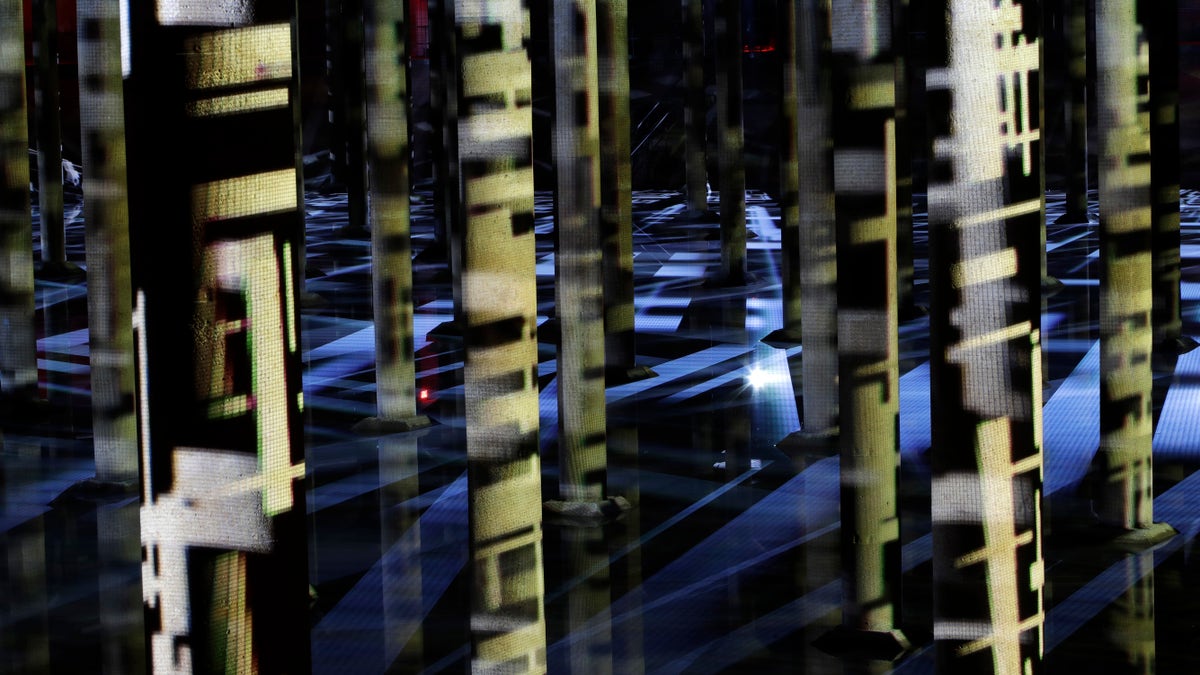
In this Friday, Dec. 16, 2016, photo, the exhibition of an abstract-video installation called "Rain" by Venezuelan artist Magdalena Fernández is projected inside a former water reservoir dubbed the "Cistern" in Houston. Once eyed for demolition, the former water reservoir built in 1926 has now found new life as a public space that's also serving as an unusual canvas for art. The reservoir's rebirth is the latest example of efforts by cities around the country to reuse and repurpose abandoned and dilapidated pieces of infrastructure as public spaces. (AP Photo/David J. Phillip) (Copyright 2016 The Associated Press. All rights reserved.)
HOUSTON – Houston's first underground drinking water reservoir — a decades-old collection of more than 200 concrete columns inside a cavernous space near downtown — had been unused for years and was set for demolition when a nonprofit group reimagined it as something new: a public space.
The 87,500-square-foot-space, dubbed the "Cistern" and reminiscent of ancient European water reservoirs, opened its doors to visitors in May. Then earlier this month, the structure's darkened pillars and walls became the canvas for a piece of modern art.
"Repurposing it for a contemporary audience is the perfect solution," said Judy Nyquist, a board member with the Buffalo Bayou Partnership, which incorporated the reservoir as part of a $58 million park renovation project.
It's the latest example of efforts by U.S. cities — including Atlanta; Buffalo, New York; Philadelphia; San Francisco; and Washington, D.C. — to repurpose abandoned and dilapidated pieces of infrastructure as public spaces. Urban planners see the preservation of historic buildings and other structures as essential in creating the kinds of communities people want to live in, said Stephanie Meeks, president and CEO of the Washington, D.C.-based National Trust for Historic Preservation.
Probably the best-known project is New York City's High Line, an abandoned elevated railroad section converted into a park in 2009. It's shown cities that such pieces of infrastructure can be diamonds in the rough, said Robert Steuteville, with the Congress for the New Urbanism, a Washington, D.C.-based nonprofit that promotes sustainable communities.

Pedestrians walks along High Line park in New York City (Reuters)
"That's why other cities are saying, 'Aha. We have this thing. What can we do with it?' Very often you can do something with it that actually generates value," he said.
In Houston, the Buffalo Bayou Partnership saw the preservation of the Cistern, first built in 1926 and decommissioned in 2007, as a way to save a piece of history and educate visitors about Houston's relationship with its bayous, which have provided both drinking water and drainage. The group also saw the Cistern as a good fit for its plans to display art throughout the renovated Buffalo Bayou Park, 160 acres that the reservoir sits next to.
The first exhibition is an abstract-video installation called "Rain" by Venezuelan artist Magdalena Fernández. The nearly two-minute video, accompanied by a soundtrack of snapping fingers and stomping heels that mimics falling rain, projects a series of white geometric shapes onto the darkened concrete columns and the shallow pool of water on the Cistern floor to evoke the atmosphere of a stormy night. It can be seen until June through scheduled tours.
In San Francisco, officials and community leaders are working to turn a reservoir shuttered in 1940 into a park. In October, officials in Philadelphia broke ground on a project to transform an abandoned rail line into a public park similar to the High Line. In Buffalo, a collection of concrete grain elevators that are remnants of the city's heyday as a shipping hub are being reused as locations for restaurants, outdoor concerts and as the projection screen for a nightly light show. In Washington, D.C, a cultural organization is transforming an abandoned trolley station underneath the Dupont Circle neighborhood into a place for exhibitions and artistic expression.
Atlanta is in the midst of a project to transform 22 miles of a mostly abandoned railroad corridor that encircles the city into a network of trails, parks, affordable homes and rail transit that will connect 45 neighborhoods. The project is set to be completed in 2030.
"This really is a legacy project that goes out 20 years, 30 years, 50 years," said Kevin Burke, senior landscape architect for the project, which is managed by the economic development agency Atlanta BeltLine Inc. "We really have to have that long view as to what we are doing and the impact that we will have not only on the current generations of Atlanta residents and visitors but those yet to come for decades."





















